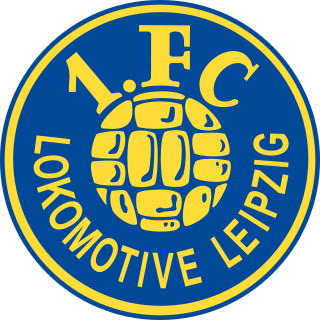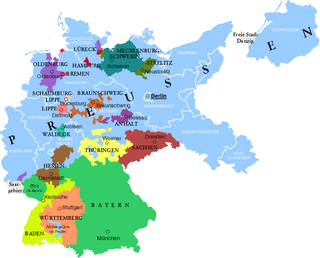
The DFB-Pokal is a German knockout football cup competition held annually by the German Football Association (DFB). Sixty-four teams participate in the competition, including all clubs from the Bundesliga and the 2. Bundesliga. It is considered the second-most important club title in German football after the Bundesliga championship. Taking place from August until May, the winner qualifies for the DFL-Supercup and the UEFA Europa League unless the winner already qualifies for the UEFA Champions League in the Bundesliga.

The German Football Association is the governing body of football in Germany. A founding member of both FIFA and UEFA, the DFB has jurisdiction for the German football league system and is in charge of the men's and women's national teams. The DFB headquarters are in Frankfurt am Main. Sole members of the DFB are the German Football League, organising the professional Bundesliga and the 2. Bundesliga, along with five regional and 21 state associations, organising the semi-professional and amateur levels. The 21 state associations of the DFB have a combined number of more than 25,000 clubs with more than 6.8 million members, making the DFB the single largest sports federation in the world.

1. Fußballclub Lokomotive Leipzig e.V. is a German football club based in the locality of Probstheida in the Südost borough of Leipzig, Saxony. The club may be more familiar to many of the country's football fans as the historic side VfB Leipzig the first national champion of Germany. It has also been known as SC Leipzig. The club won five titles in FDGB-Pokal and the 1965–66 Intertoto Cup during the East German era. It also finished runner-up in the 1986–87 European Cup Winners' Cup. 1. FC Lokomotive Leipzig was renamed VfB Leipzig after German re-unification and managed to qualify for the Bundesliga in 1993. However, like many clubs of the former DDR-Oberliga, VfB Leipzig faced hard times in re-unified Germany and a steady decline soon followed. 1. FC Lokomotive Leipzig was refounded in 2003 and has reclimbed through divisions since then. The team competes in the fourth tier Regionalliga Nordost as of 2021. The 1. in front of the club's name indicates that it was the first to be founded in the city.

VfR Mannheim is a German association football club based in Mannheim, Baden-Württemberg formed in 1911 out of the fusion of Mannheimer FG 1896, Mannheimer FG 1897 Union, and FC Viktoria 1897 Mannheim. The club captured the national title in 1949 with a victory over Borussia Dortmund. They have played through most of its recent history as an unheralded local amateur side and were, until 2015, part of the Oberliga Baden-Württemberg (V).

Berliner Fußball-Club Viktoria 1889 was a German sports club based in the Tempelhof district of Berlin. Football, rugby, and cricket came to continental Europe in the late 19th century, and these "English games" became immediately popular in many countries. Viktoria was the oldest club in Germany that had teams playing both football and cricket. It was one of the founding members of the German Football Association (DFB) in Leipzig in 1900. The club merged with Lichterfelder FC in 2013 and has continued as FC Viktoria 1889 Berlin.

Berliner SV 1892 is a German association football club from the district of Wilmersdorf, Berlin. BSV is one of the country's oldest clubs and was a founding member of the DFB in 1900. The club also operates a rugby union department, Berliner SV 92 Rugby, which, in 1948, reached the German rugby union championship final.
Viktoria 96 Magdeburg was a German football club playing in the Cracau district of Magdeburg, Saxony-Anhalt.
Luftwaffen-SV Hamburg was a short-lived military German association football club active during World War II and is notable as the most successful of the wartime military sides.

Football in Berlin, the capital of Germany, has a long history. The city contributed 24 of the 86 founders of the DFB, the German Football Association. The DFB Cup Final has been held every year at the Olympiastadion since 1985.
The history of German football is one that has seen many changes. Football was a popular game from early on, and the German sports landscape was dotted with hundreds of local sides. Local sports associations or clubs are a longtime feature of the culture of German athletics. Each club would participate in, and field teams from, one or more sports, depending on local interest and resources.

The Brandenburg football championship was the name of highest association football competition in the Prussian Province of Brandenburg, including Berlin, established in 1898. The competition was organized by various regional football associations between 1898 and 1933. The last incarnation of the competition was the VBB-Oberliga. The competition was disbanded in 1933 with the rise of the Nazis to power.

The 1948 German football championship, the 38th edition of the competition, was the culmination of the 1947–48 football season in Allied-occupied Germany. 1. FC Nürnberg were crowned champions for the seventh time after one-leg knock-out tournament. It was the first time the championship had been played since 1944. It was Nürnberg's tenth appearance in the final. For the losing finalists 1. FC Kaiserslautern, it was the first appearance in the final since the establishment of a national championship in 1903.
The Introduction of the Bundesliga was the long-debated step of establishing a top-level association football league in Germany in 1963. The new league, the Bundesliga, played its first season in 1963–64 and continues to be the highest league in the country. Its introduction reduced the number of first division teams in Germany from 74 to 16 and finally eliminated the problem of the top-teams having to play uncompetitive teams in regional leagues.
The 1903 German football championship was the first tournament sanctioned by the German Football Association (DFB) to crown a national champion. At the time, the newly founded DFB only had about 150 member clubs in 30 mostly local associations. Every champion of these associations was eligible for play in the championship. Additionally, associations from outside Germany were allowed to take part, such as the Prague association that sent her champion to Germany.
The 1942 German football championship, the 35th edition of the competition, was won by Schalke 04, the club's sixth championship, won by defeating First Vienna FC in the final. It marked the third and last occasion of a club from Vienna in the final, Rapid Wien having won the competition in the previous season while Admira Wien had made a losing appearance in the 1939 final. It was the last time that Schalke was awarded the Viktoria, the annual trophy for the German champions from 1903 to 1944 as the trophy disappeared during the final stages of the Second World War.
The 1943 German football championship, the 36th edition of the competition, was won by Dresdner SC, the club's first-ever championship, won by defeating FV Saarbrücken in the final.
The 1944 German football championship, the 37th edition of the competition, was won by Dresdner SC, the club defending its 1943 title by defeating Luftwaffe team LSV Hamburg in the final.
The 1949 German football championship, the 39th edition of the competition, was the culmination of the 1948–49 football season in Germany. VfR Mannheim were crowned champions for the first time after a one-leg knock-out tournament. It was both sides' first appearance in the final.
The Meisterschale, colloquially referred to as the Salatschüssel, is a German association football trophy which has been awarded to the German champions since 1949 and the Bundesliga champions since 1963–64. It replaced the Viktoria, which was the original trophy since 1903 but which disappeared during the final stages of the Second World War only to resurface after the German reunification.









